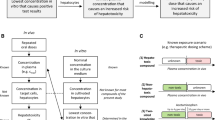Abstract
The liver is extremely vulnerable to the effects of xenobiotics due to its critical role in metabolism. Drug-induced hepatotoxicity may involve any number of different liver injuries, some of which lead to organ failure and, ultimately, patient death. Understandably, liver toxicity is one of the most important dose-limiting considerations in the drug development cycle, yet there remains a serious shortage of methods to predict hepatotoxicity from chemical structure. We discuss our latest findings in this area and present a new, fully general in silico model which is able to predict the occurrence of dose-dependent human hepatotoxicity with greater than 80% accuracy. Utilizing an ensemble recursive partitioning approach, the model classifies compounds as toxic or non-toxic and provides a confidence level to indicate which predictions are most likely to be correct. Only 2D structural information is required and predictions can be made quite rapidly, so this approach is entirely appropriate for data mining applications and for profiling large synthetic and/or virtual libraries.
Similar content being viewed by others
References
Farrell, G.C. Drug-Induced Liver Disease. Churchill Living-stone, New York, 1994.
Zimmerman, H.J. Hepatotoxicity: The Adverse Effects of Drugs and Other Chemicals on the Liver. Lippincott Williams & Wilkins, Philadelphia, PA 1999.
AASLD/FDA/PhRMA Hepatotoxicity Workshop, Chantilly, VA, 2001.
Source Book of Flavors. Chapman & Hall, New York, 1994.
Coultate, T.P. Food: the Chemistry of its Components, The Royal Society of Chemistry, Cambridge, UK, 1996.
Stricker, B.H.C. Drug-Induced Hepatic Injury, Elsevier, Amsterdam, 1992.
Physicians' Desk Reference: Electronic Library, Thomson Micromedex, Inc., CO Greenwood Village, 2001.
Registry of Toxic Effects of Chemical Substances (RTECS), The National Institute for Occupational Safety and Health, Cincinnati, OH.
Toxicology Data Network (TOXNET), U.S. National Library of Medicine, Bethesda, MD.
FDA Generally Recognized as Safe (GRAS) List, U.S. Food and Drug Administration, Rockville, MD.
Fenaroli's Handbook of Flavor Ingredients. CRC Press, Boca Raton, FL, 1995.
Gold, E.J., Mertelsmann, R.H., Itri, L.M., Gee, T., Arlin, Z., Kempin, S., Clarkson, B. and Moore, M.A., Cancer Treatment Reports, 67 (1983) 981.
Guzzo, C., Benik, K., Lazarus, G., Johnson, J. and Weinstein, G., Arch. Dermatol., 127 (1991) 511.
Knip, M., Douek, I.F., Moore, W.P.T., Gillmor, H.A., McLean, A.E.M., Bingley, P.J. and Gale, E.A.M., Diabetologia, 43 (2000) 1337.
Lagadic-Gossmann, D., Rissel, M., Le Bot, M.A. and Guil-louzo, A., Cell Biol. Toxicol., 14 (1998) 361.
Lakhanpal, S., Donehower, R.C. and Rowinsky, E.K., Invest. New Drugs, 19 (2001) 69.
O'Brien, J.T., Eagger, S. and Levy, R., Age and Ageing, 20 (1991) 129.
Raber, M.N., Newman, R.A., Newman, B.M., Gaver, R.C., Schacter, L.P., Cancer Res., 52 (1992) 1406.
Rowinsky, E.K., Noe, D.A., Ettinger, D.S., Christian, M.C., Lubejko, B.G., Fishman, E.K., Sartorius, S.E., Boyd, M.R. and Donehower, R.C., Cancer Res., 53 (1993) 1794.
Ryan, D.P., Supko, J.G., Eder, J.P., Seiden, M.V., Demetri, G., Lynch, T.J., Fischman, A.J., Davis, J., Jimeno, J. and Clark J.W., Clin. Cancer Res., 7 (2001) 231.
Von Mehren, M., Giantonio, B.J., McAleer, C., Schilder, R., McPhillips, J. and O'Dwyer, P.J., Invest. New Drugs, 13 (1995) 205.
Vogel, C.L., Gorowski, E., Davila, E., Eisenberger, M., Kosinski, J., Agarwal, R.P. and Savaraj, N., Invest. New Drugs, 5 (1987) 187.
Dixon, S.L. and Villar, H.O., J. Comput.-Aided Mol. Design, 13 (1999) 533.
Susnow, R.G. and Dixon, S.L., J. Chem. Inf. Comput. Sci., 43 (2003) 1308.
Breiman, L., Friedman, J.H., Olshen, R.A. and Stone, C.J. Classification and Regression Trees. Wadsworth International Group, Belmont, CA, 1984.
Hawkins, D.M. and Kass, G.V., Topics in Applied Multivariate Analysis, Hawkins, D.H., Ed., Cambridge University Press, Cambridge, UK, 1982, p. 269.
Breiman, L. and Machine Learning, 24 (1996) 123.
Freund, Y., Information and Computation, 121 (1995) 256.
Cerius 2, Accelrys, San Diego, CA, 2001.
Dixon, S.L., Kenneth M. and Merz, J., J. Med. Chem., 44 (2001) 3795.
S-PLUS 6.1 for Windows, Insightful Corporation, Seattle, WA, 2001.
Author information
Authors and Affiliations
Rights and permissions
About this article
Cite this article
Cheng, A., Dixon, S.L. In silico models for the prediction of dose-dependent human hepatotoxicity. J Comput Aided Mol Des 17, 811–823 (2003). https://doi.org/10.1023/B:JCAM.0000021834.50768.c6
Issue Date:
DOI: https://doi.org/10.1023/B:JCAM.0000021834.50768.c6




